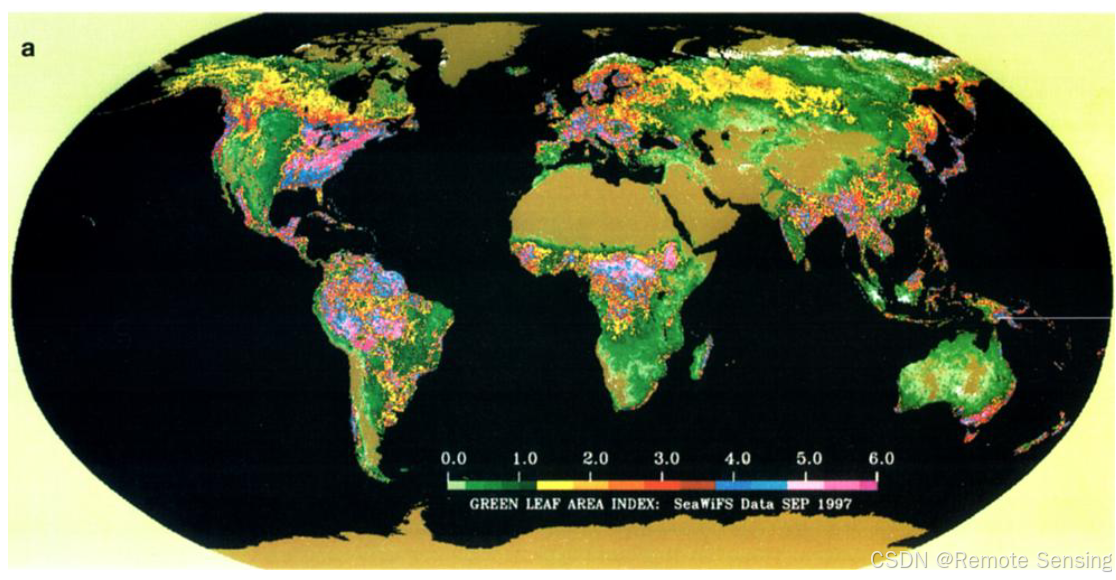Boundary Conditions of Canopy Radiative Transfer Equation

Introduction
The stationary radiative transfer equation for a vegetation canopy in the domain V is
Ω⋅∇I(r,Ω)+G(r,Ω)uL(r)I(r,Ω)=uL(r)π∫4πΓ(r,Ω′,Ω)I(r,Ω′)dΩ′
\begin{aligned}
\Omega\cdot \nabla I(r,\Omega)&+G(r,\Omega)u_L(r)I(r,\Omega)=\\ &\frac{u_L(r)}{\pi}\int_{4\pi}\Gamma(r,\Omega',\Omega)I(r,\Omega')d\Omega'
\end{aligned}
Ω⋅∇I(r,Ω)+G(r,Ω)uL(r)I(r,Ω)=πuL(r)∫4πΓ(r,Ω′,Ω)I(r,Ω′)dΩ′
with the boundary condition
I(rb,Ω)=B(rb,Ω), rb∈δV,n(rb)⋅Ω<0
I(r_b,\Omega)=B(r_b,\Omega), \ \ r_b\in\delta V, n(r_b)\cdot\Omega <0
I(rb,Ω)=B(rb,Ω), rb∈δV,n(rb)⋅Ω<0
Given the BRF R0(Ω′,Ω)R_0(\Omega', \Omega)R0(Ω′,Ω), incident radiance at point rtr_trt, I(rt,Ω′)I(r_t,\Omega')I(rt,Ω′), then the intensity of reflected radiation I(rt,Ω)I(r_t,\Omega)I(rt,Ω) is
I(rt,Ω)=∫2π−R0(Ω′,Ω)π∣μ′∣I(rt,Ω′)dΩ′
I(r_t,\Omega)=\int_{2\pi-}\frac{R_0(\Omega',\Omega)}{\pi}|\mu'|I(r_t,\Omega')d\Omega'
I(rt,Ω)=∫2π−πR0(Ω′,Ω)∣μ′∣I(rt,Ω′)dΩ′
To understand this equation, we view the term ∣μ′∣I(rt,Ω′)dΩ|\mu'|I(r_t,\Omega')d\Omega∣μ′∣I(rt,Ω′)dΩ as the unit flux density, and then R0(Ω′,Ω)π\frac{R_0(\Omega',\Omega)}{\pi}πR0(Ω′,Ω) is actually the BRDF, then R0(Ω′,Ω)π∣μ′∣I(rt,Ω′)dΩ′\frac{R_0(\Omega',\Omega)}{\pi}|\mu'|I(r_t,\Omega')d\Omega'πR0(Ω′,Ω)∣μ′∣I(rt,Ω′)dΩ′ means the radiance leaving with unit incident radiance from dΩ′d\Omega'dΩ′. After that, integral means sum the radiance from all directions.
Boundary Conditions
There are three boundary of the conopy, top δVt\delta V_tδVt, the bottom δVb\delta V_bδVb and the lateral δVl\delta V_lδVl. The general form of boundary condtions is
I(rb,Ω)=∫δV∫Ω′⋅n(rb′)>0ρ(rb′,Ω′;rb,Ω)∣n(rb′)⋅Ω′∣I(rb′,Ω′)dΩ′drb′+q(rb,Ω), n(rb)⋅Ω<0
\begin{aligned}
&I(r_b,\Omega)=\\&\int_{\delta V}\int_{\Omega'\cdot n(r_b')>0}\rho(r_b',\Omega';r_b,\Omega)|n(r_b')\cdot\Omega'|I(r_b',\Omega')d\Omega' dr_b'\\
&+ q(r_b,\Omega), \ \ n(r_b)\cdot \Omega <0
\end{aligned}
I(rb,Ω)=∫δV∫Ω′⋅n(rb′)>0ρ(rb′,Ω′;rb,Ω)∣n(rb′)⋅Ω′∣I(rb′,Ω′)dΩ′drb′+q(rb,Ω), n(rb)⋅Ω<0
rbr_brb nad rb′r_b'rb′ are points on the conopy boundary δV\delta VδV, n(rb)n(r_b)n(rb) is outward normal at point rbr_brb, and ρ\rhoρ is boundary scattering function (similar to BRF), means the probability density that a photon escaped from rb′r_b'rb′ in direction Ω′\Omega'Ω′ will come back to it through rbr_brb with direction Ω\OmegaΩ. qqq is a photon source.
The Ω′⋅n(rb′)\Omega'\cdot n(r_b')Ω′⋅n(rb′) means photon escape from δV\delta VδV, and n(rb)⋅Ω<0n(r_b)\cdot\Omega <0n(rb)⋅Ω<0 means the photon enter δV\delta VδV.
1. Upper Boundart
The boundary condtion at δVt\delta V_tδVt is
I(rt,Ω)=cT(rt)δ(Ω,Ω0)+d(rt,Ω), rt∈δVt, μ<0.
I(r_t,\Omega)=c_T(r_t)\delta(\Omega,\Omega_0)+d(r_t,\Omega), \ r_t\in\delta V_t,\ \mu<0.
I(rt,Ω)=cT(rt)δ(Ω,Ω0)+d(rt,Ω), rt∈δVt, μ<0.
Here, cTc_TcT is intensities of solar beam and diffuse radiation at rtr_trt. The condtion, μ<0\mu < 0μ<0, which is equivelent to n(rt)⋅Ω<0n(r_t)\cdot\Omega <0n(rt)⋅Ω<0, means this is the incoming directions. With Equation (4), this means ρ=0\rho=0ρ=0 and q(rb,Ω)=cT(rt)δ(Ω,Ω0)+d(rt,Ω)q(r_b,\Omega)=c_T(r_t)\delta(\Omega,\Omega_0)+d(r_t,\Omega)q(rb,Ω)=cT(rt)δ(Ω,Ω0)+d(rt,Ω).
How to determine the ccc and ddd? We define the ratio fdirf_{dir}fdir of the mono-drectional to the total radiantion flux density ont the canopy:
fdir(rt)=Fdir↓(rt)Fdir↓(rt)+Fdif↓(rt),rt∈δVt
f_{dir}(r_t)=\frac{F_{dir}^{\downarrow}(r_t)}{F_{dir}^{\downarrow}(r_t)+F_{dif}^{\downarrow}(r_t)}, \quad r_t\in\delta V_t
fdir(rt)=Fdir↓(rt)+Fdif↓(rt)Fdir↓(rt),rt∈δVt
Here, Fdir↓(rt)F_{dir}^{\downarrow}(r_t)Fdir↓(rt) and Fdif↓(rt)F_{dif}^{\downarrow}(r_t)Fdif↓(rt) is flux density of mono-direction and diffuse components of incident radiation, i.e.,
Fdir↓(rt)=cT∣μ0∣,Fdif↓(rt)=∫2π−d(rt,Ω)∣Ω⋅n(rt)∣dΩ
F_{dir}^{\downarrow}(r_t)=c_T|\mu_0|, \quad F_{dif}^{\downarrow}(r_t)=\int_{2\pi-}d(r_t,\Omega)|\Omega\cdot n(r_t)|d\Omega
Fdir↓(rt)=cT∣μ0∣,Fdif↓(rt)=∫2π−d(rt,Ω)∣Ω⋅n(rt)∣dΩ
The μ0=cosθ0\mu_0=cos\theta_0μ0=cosθ0. And naturely we have F↓(rt)=Fdir↓(rt)+Fdif↓(rt)F^{\downarrow}(r_t)=F_{dir}^{\downarrow}(r_t) + F_{dif}^{\downarrow}(r_t)F↓(rt)=Fdir↓(rt)+Fdif↓(rt). The quantaty fdirf_{dir}fdir and F↓F^{\downarrow}F↓ could be derived from satellite data. Then, using these notions, we get
I(rt,Ω)=[fdir∣μ0∣δ(Ω,Ω0)+(1−fdir)do(rt,Ω)]F↓,n(rt)⋅Ω<0
I(r_t,\Omega)=[\frac{f_{dir}}{|\mu_0|}\delta(\Omega,\Omega_0)+(1-f_{dir})d_o(r_t,\Omega)]F^{\downarrow}, n(r_t)\cdot\Omega<0
I(rt,Ω)=[∣μ0∣fdirδ(Ω,Ω0)+(1−fdir)do(rt,Ω)]F↓,n(rt)⋅Ω<0
Here, d0(rt,Ω)=d(rt,Ω)Fdif↓d_0(r_t,\Omega)=\frac{d(r_t,\Omega)}{F_{dif}^{\downarrow}}d0(rt,Ω)=Fdif↓d(rt,Ω).
2. Conopy lower bound
The reflective properties of canopy lower boundary is approximated as
ρ(rb′,Ω′;rb,Ω)=ρb(rb′,Ω′,Ω)δ(rb,rb′)
\rho(r_b',\Omega';r_b,\Omega)=\rho_b(r_b',\Omega',\Omega)\delta(r_b,r_b')
ρ(rb′,Ω′;rb,Ω)=ρb(rb′,Ω′,Ω)δ(rb,rb′)
Here, ρb\rho_bρb is the BRF of canopy ground. Then we get that
I(rb,Ω)=1π∫2π−ρb(rb,Ω′,Ω)∣n(rb)⋅Ω′∣I(rb,Ω′)dΩ′, μ>0
I(r_b,\Omega)=\frac{1}{\pi}\int_{2\pi-}\rho_b(r_b,\Omega',\Omega)|n(r_b)\cdot\Omega'|I(r_b,\Omega')d\Omega', \ \mu >0
I(rb,Ω)=π1∫2π−ρb(rb,Ω′,Ω)∣n(rb)⋅Ω′∣I(rb,Ω′)dΩ′, μ>0
3. Lateral Boundary contition
This could be assumted to 0 when radiation regime is large.





















 388
388

 被折叠的 条评论
为什么被折叠?
被折叠的 条评论
为什么被折叠?








